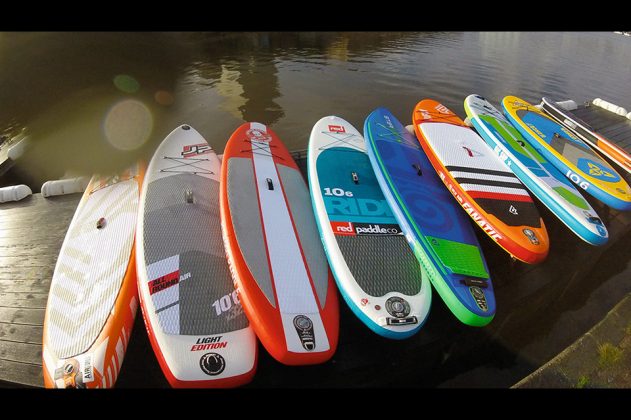ALL ROUND iSUPS – REVIEW 2017
Test Editor Dave Ewer
INFLATABLE PADDLE BOARDS? At one time, the idea of having a board you pump up seemed crazy. In fact some of the early boards were just that, crazy: difficult to pump up, bendy and unstable. You can still buy these type of boards if you go cheap enough on some auction sites, thankfully though we’re safely into a new epoch of iSUP board design.
This test review was originally published in the Spring 2017 issue of SUP International Magazine.
A BRIEF HISTORY OF BLOW UPS
Whizz back seven or eight years ago and some inflatables at the budget end of the emerging iSUP market had lots of rocker built in, poor pumps and a useless bag you could barely get the board into. I’ve actually seen people up to their shins in water with the banana rocker line exposing the fins even when the board was pumped up.
I was told a while ago by a well know leading iSUP pioneer that he was so proud of his new “rucksack” back pack that he tried walking to the beach with it one hot sunny day with some family and friends. By the time he struggled to get his board back in to the bag and ended up carrying the pump and paddle separately back he never wanted to see a flimsy back pack again (this later drove him to develop a market leading iSUP bag, with wheels!) Sure enough the early pumps were nigh on impossible to use much above 10psi unless you were built like a gorilla, so most people were paddling around on iSUP’s at around 7-8psi which wasn’t a great start. As you may be able to discern, I wasn’t a great fan of the early inflatable boards, but then again not a lot of people were. I’d always prefer to use a hard epoxy board any day and so would most people. However, I now find myself with a van full of them every summer as I end up using them in my school and with family and friends more and more. My rental boards are pretty much all iSUPs and generally they play a big part of my life, should they in yours too?
Most of the pessimism against iSUPs have been dispelled, the shape and performance of the main brands has snowballed forward with enormous momentum and has brought some very polished kit to market. The boards are now thicker (so less bendy), the pumps have been completely redesigned for purpose meaning you can now get your kids to pump up your board and the bags have now moved on to a smart piece of wheel-able luggage ready for your next holiday flight – housing your paddle and pump inside too.
iSUPs are very much part of the fabric of our sport and are taking more and more of the market share each season. They’re so good now that we often get asked about them after lessons; many of our pupils not realising that they’ve just been paddling one for nearly two hours!
The UK market for SUP has changed hugely from 100% hard boards to around 60-40% in favour of the blow up paddle board. I fully recommend a hard board for a more performance feel and of course they are immeasurably better for riding waves but for most people buying their first board for just pottering about, an inflatable will often be more appealing.
So why would you buy an iSUP over a hard board? If you want a durable board you can loan to your mates that fits in the back of your company car (and doesn’t look like you’re ‘going surfing’ after work) this new strain of iSUP should be just the ticket. On the weekends your kids can jump all over it without giving you a nervous twitch and you can relax as you see them ramming it into your local pier; they’ll survive most things. But if you live near the coast and aspire to ride some waves a hard board is still the preferred choice.
This test we’re not surfing and this collection of iSUPs (some we know well) has really been under the microscope. We’ve tested each pump and bag, weighed all the boards for you and got the inside tech knowledge from the manufacturers too. Each board was glide tested and measured for stiffness at 15psi in our deflection test. We’ve also had a selection of guest testers chuck their thoughts into the pot too.
HOW WE CONDUCTED THE ISUP TESTS
We tested these boards all together, back to back to back with input from several paddlers.
Glide testing
We simply see which board covers the most distance in a given amount of paddle stokes on sheltered flat water, then retest back to the start and check again. Same rider, same paddle, same stroke rate. Usually you can guess which board is going to be quicker by length, width, weight and board shape and we’ve categorised the boards into groups of three. Glide isn’t a deal breaker, these aren’t race boards.
Stiffness testing
Everyone wants an iSUP to feel like a hard board. There wasn’t a great deal surprisingly between the bendiest board and the stiffest board, they did feel quite different on the water though. If you want the stiffest board check out the measurements. To test, we pumped each board up to 15psi, rested them on bars 180cm apart and placed a 90kg weight in the centre of the board. The difference between having the weight on and off the board is the measurement in cm deflected, of course you can pump your board up more to make it stiffer, and a thinner board will usually be bendier, but there it is.
ALL BOARDS ARE NOT CREATED EQUAL
Construction
Most of the more refined boards are now made by fusing two materials together to create a double layer before making the board, rather than two pieces glued together on top of another. This fusing process cuts out a layer of glue, saves weight and creates an easy to roll and store board. It also has great durability and really is the best construction. The cheaper (and less durable) method is to simply have a single layer skin; this creates a light but less durable board which is bendier and more prone to leaking air in the long term. To the untrained eye they look very similar but are vastly different on the water and in terms of durability. Until recently, most brands went for a tried and tested double glued layer giving a tough construction and a stiff but weighty feel, these were less easy to roll up but were hardy and reliable.
Rails
The rails on this collection of boards range from a simple single skin wall to a wrapped multi-layer rail with stiffening materials. A multi-layer rail promotes stiffness and durability and will give years of problem free paddling. A single layer rail will be easy to roll up and saves weight, but you’re just one nick away from a deflating board at sea. I wouldn’t recommend bouncing off rocks on one of these.
Stiffness is key
In order to make a board stiff manufacturers have come up with all sorts of ideas, everything from extra layers on the rails to Dyneema belts running up and down the board, even fiberglass batten inserts for the rails. This year Red Paddle have even attached a carbon pole on top of the front of their new iSUP race board to increase stiffness.
Price
This iSUP test we have boards from £409 to over £900. A huge range, what determines the price to the consumer can vary vastly. The higher price boards from the well-known brands have in some cases evolved over nearly ten years of development. These boards have great features and paddle extremely well, have a good dealer back up and if you ever decide to sell on they’ll hold their price like you won’t believe. They cost around 25-30% more but should last for years anyway. The more budget boards are often newer to market, directly imported by a shop or direct via a website. Some of these boards share some features with the big brands and represent good value for money. However some budget brands tend to cut corners to buy themselves a market share; such boards tend to be bendier, less robust and lack refinement. For light riders and kids they would be fine most of the time. Curiously enough on the test, the best boards weren’t the cheapest, and the cheapest boards weren’t the best…
What’s on offer
We’ve got the premium big guns as well as some cheaper direct to market stuff too. Red Paddle and O’Shea both have a similar feel and use a tried and very well tested formula – no flashy artifice but they’re really well built all-rounders. The Fanatic and the Loco are our two windsurfable boards (although reading this won’t find out how they sail as it’s a SUP magazine I’m afraid), that’s one brand right at the peak of the market and Loco, new to iSUPs . The new Bic, Starboard and RRD look look very similar but felt very different on the water one very solid, (thicker too – RRD) while the Bic felt lighter and more nimble. Then the Starboard felt almost springy but was much loved by the testers. Then we have the amazingly light and quick JP which was a real favourite for the lighter testers, and the budget Redwood which certainly got our attention even before considering the price… SUP
ON TEST
• FANATIC FLY AIR PREMIUM 10’4


